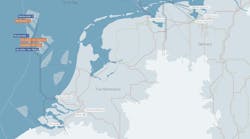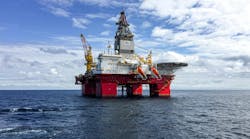Leonard LeBlanc
Houston
The cycloidal blade "whale tail" wheel achieves an open water power-to-thrust efficiency of 80%.
Chemical markers indicate source-to-trap distances
Chemical analysis of produced oil provides information about source beds for trapped hydrocarbons, reservoir connectivity, and migration pathways. From this, geologists can conduct better prospect delineation, well positioning, and build better sequence stratigraphy models. However, source rock identification doesn't help much when there are a multitude of potential sources in the area or none at all. A research team from Shell, Saga Petroleum, Norsk Hydro, Imperial Oil, and the University of Newcastle has stepped closer to resolving the latter issue.A method to gauge the distance traveled by migrating hydrocarbons has been devised by the team. The method utilizes two forms of a carbon-nitrogen compound known as benzocarbazole, contained in trace amounts in all hydrocarbons. One form, benzo (a) carbazole, is absorbed by clays and other minerals faster that the other form, benzo (c) carbazole. The absence of benzo (a) carbozole in the ratio is proportional to the distance traveled by the crude, regardless of the amount of migration time. The assumption is that the ratios are proportional when migration from the source began, although scientists are not certain that will always be the case. Nor are they certain whether vertical migration can be as accurately characterized as lateral movement.
On the exploration side, once source rocks have been identified, additional migration routes and reservoir pays can be developed in combination with 3D seismic. Further, many hydrocarbon accumulations are secondary, and tracing a route to primary accumulations could prove rewarding.
Dealing with transverse expansion variance between FRP, concrete
The concrete layer covering fiber reinforced plastic (FRP) used for reinforcement and prestressing must be large enough to contain a transverse thermal expansion 5-8 times that of the surrounding concrete. At a minimum, unless the covering is 4-5 times bar diameter, a temperature change of 60 degrees C will split the concrete.
FRP is being used more as a reinforcement element in concrete, replacing steel bar and frames members, because of FRP's high axial strength, low weight, and high corrosion resistance to halide environments. The three characteristics make it especially attractive for marine environments.
Users have been cautioned by researchers not to reduce concrete covering when using FRP where temperature variations are great. FRP's longitudinal coefficient of expansion is much smaller than the transverse change, and not a concern. The thermal expansion loading values, depending on concrete strength and shape of the prestressing element, were determined using a finite element analysis performed with a DIANA program.
Reference:Schuttter, G., Matthys, S., Taerwe, L., Two-Dimensional Analysis of Thermal Incompatibility Between FRP Reinforcement and Concrete, Diana World, Issue 2, 1996.
Residual stress evaluation using neutron diffraction
Knowing the residual stresses left in metals following manufacturing becomes important when those stresses accelerate metal fatigue or are transferred to external loads (metal-to-metal seals, weight bearings, etc.). Determining those stresses can be difficult unless sample fabrications can be destroyed in testing, so an Italian group has developed a neutron diffraction method to determine stress loading.
The Istituto di Scienze Fisiche at the Universita deg* Studi de Ancona (Ancona, Italy) has developed a small angle neutron scattering process, which provides information on the local atomic disorder and micro-heterogeneities in very thick metal components. The process can distinguish between base metals of close atomic numbers and isotopes of the same elements, and detects light elements such as hydrogen and helium enclosed in metals.
Emergency welding kit may go subsea
Thermite-metal foils that are shaped to fit cracks in metal structures, ignited, and in seconds leave a welded connection, could be used to re-join underwater structures. The process has been developed for quick open-air repairs in areas difficult to reach with conventional welding equipment, but could be modified with seals and shielding gases for hyperbaric applications. The high cost of conventional hyperbaric welding provides an incentive to further develop the thermite-metal process.
The patented emergency welding process was developed by Timothy Weihs of Johns Hopkins University and Troy Barbee of Lawrence Livermore National Laboratory (both USA). The process combines aluminum with various metal oxides to precisely control heat release and final temperatures. A major benefit of the welding process is that it evolves so quickly, the heat affected zone is minimized.
Subduction study may shed light on accretion, rising gases
Scientists know that subduction zones induce fracturing in overlying rocks, but aren't certain whether they also play a role in the creation of long-chain hydrocarbons. Saudi Arabia, offshore California, and Indonesia are hydrocarbon-prone areas where high subduction rates are underway, but former subduction areas are active hydrocarbon producers too.
Without the ability to study subducted sediments, the changes wrought by extremely high temperatures and pressures, or the movement of lighter compounds and gases through the fractures created above the subduction zone to overlying basin traps or areas of equivalent density, scientists are guessing at subduction behaviors.
In an effort to get a better idea of subducted volumes and contents, Ocean Drilling Program scientists are studying a highly visible process taking place off Costa Rica. Although early in the study, findings show about 240 meters of a total 400 vertical meters of sedimentary material is being fully subducted. The remainder is scraped off at the subduction edge or soon afterward. Additional studies are expected to shed more light on the disposition and movement of the accreted material under the overlying plate.
Cycloidal blade wheel simulates whale tail
A cycloidal blade propulsion unit developed by the Maritime Research Insitute in The Netherlands simulates the highly efficient movement of a whale's tale. The propulsion unit resembles a paddle wheel in the use of a horizontal shape, but has 4-7 moving blades like a Voith-Schneider tractor unit. Four vessels testing the new unit have improved propulsion efficiencies by an average of 10% over conventional propellers.
The cycloidal blades are secured on both ends of a wheel which spans 80% of the aft width of the vessel, unlike the Voith Schneider blades, which project down from the hull. The wheel has a diameter 65% that of hull draft or a maximum of two meters. The propulsion blades experience very light loading and low rotation rates. In addition, they remain cavitation-free for most of each cycle, unlike conventional propellers.
Copyright 1997 Offshore. All Rights Reserved.






